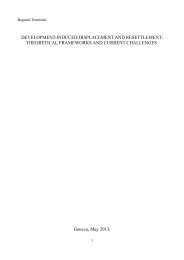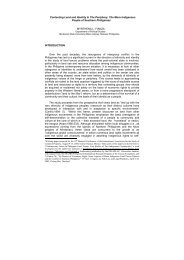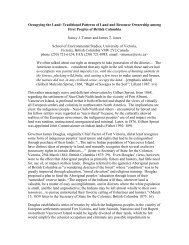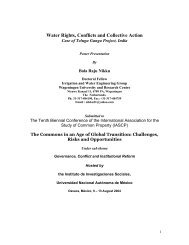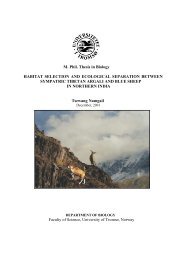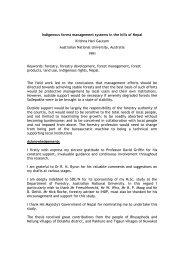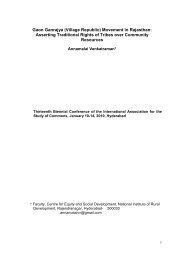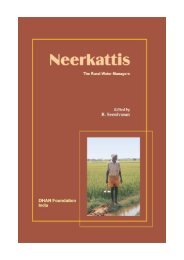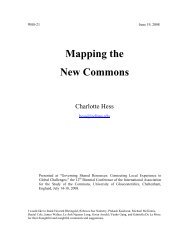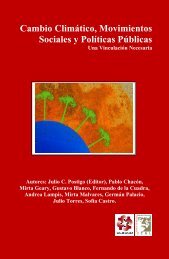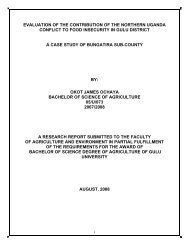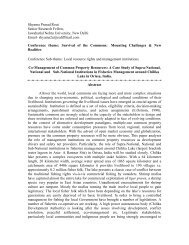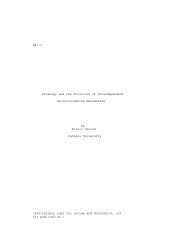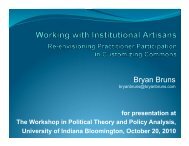SEED DIVERSITY IN THE DRYLANDS: WOMEN AND FARMING IN ...
SEED DIVERSITY IN THE DRYLANDS: WOMEN AND FARMING IN ...
SEED DIVERSITY IN THE DRYLANDS: WOMEN AND FARMING IN ...
Create successful ePaper yourself
Turn your PDF publications into a flip-book with our unique Google optimized e-Paper software.
GATEKEEPERSERIES<br />
126<br />
<strong>SEED</strong> <strong>DIVERSITY</strong> <strong>IN</strong><br />
<strong>THE</strong> <strong>DRYL<strong>AND</strong>S</strong>:<br />
<strong>WOMEN</strong> <strong>AND</strong> FARM<strong>IN</strong>G<br />
<strong>IN</strong> SOUTH <strong>IN</strong>DIA<br />
Carine Pionetti<br />
2006
EXECUTIVE SUMMARY<br />
<strong>SEED</strong> <strong>DIVERSITY</strong> <strong>IN</strong><strong>THE</strong> <strong>DRYL<strong>AND</strong>S</strong>: <strong>WOMEN</strong> <strong>AND</strong> FARM<strong>IN</strong>G <strong>IN</strong> SOUTH <strong>IN</strong>DIA ● 1<br />
Seeds are central to farming and food production. Saving, selecting, reproducing,<br />
storing and sowing those seeds is often dependent on women’s knowledge and<br />
expertise. In the dryland farming systems of South India’s Deccan Plateau, women’s<br />
roles in maintaining seed and crop diversity enable rural families to cope with the<br />
region’s many environmental demands. Here seeds and their management form an<br />
economy all of their own, whereby self-reliance in seed, crop diversity and nutrition<br />
are closely intertwined.<br />
But increasingly, seeds are becoming the ‘property’ of the private sector and big<br />
business. The burgeoning seed industry undermines the scope for farmers to save<br />
their own seed through a mix of technological, legal and economic strategies. These<br />
include reducing the genetic variability of new crop varieties through pureline<br />
breeding methods or genetically engineered seed sterility; intellectual property rights<br />
regimes such as breeders’ rights and patents which make it illegal for farmers to<br />
reuse seeds; variety registration and seed certification schemes backed by economic<br />
rules or subsidies; and gender-blind laws which provide no scope for enhancing<br />
women farmers’ practices, choices and concerns in the realms of biodiversity and<br />
seed production.<br />
This has serious implications for women as autonomous seed producers by:<br />
1. degrading their knowledge systems and innovation capacity<br />
2. destroying an activity that provides a living for marginal and landless farmers<br />
3. undermining solidarity networks on which poor rural households critically rely<br />
4. undermining women’s status and intra-household bargaining power as their role<br />
in seed and grain management is eroded by market forces<br />
5. destroying localised seed economies: seed regulations hamper farmer-to-farmer<br />
seed exchanges that have been shown to reinforce ecological sustainability and<br />
to secure livelihood and social capital in rural communities<br />
The author argues that a radical re-orientation of public policies is needed to<br />
support autonomous seed production. Poverty alleviation and biodiversity conservation<br />
both directly depend on:<br />
1. Strengthening diversity-based farming systems<br />
2. Institutional support for decentralised seed systems<br />
3. Shifting policy orientations so that technical and legal developments support,<br />
rather than undermine, autonomous seed production
2 ● GATEKEEPER 126<br />
<strong>THE</strong> GATEKEEPER SERIES of the Natural Resources Group at IIED is produced<br />
by the Sustainable Agriculture and Rural Livelihoods Programme. The Series aims to<br />
highlight key topics in the field of sustainable natural resource management. Each<br />
paper reviews a selected issue of contemporary importance and draws preliminary<br />
conclusions for development that are particularly relevant for policymakers,<br />
researchers and planners. References are provided to important sources and<br />
background material. The Series is published three times a year and is supported by<br />
the Swedish International Development Cooperation Agency (Sida), the Swiss<br />
Agency for Development and Cooperation (SDC) and the Rockefeller Foundation.<br />
The views expressed in this paper are those of the author(s), and do not necessarily<br />
represent those of the International Institute for Environment and Development<br />
(IIED), Swedish International Development Cooperation Agency (Sida), the Swiss<br />
Agency for Development and Cooperation (SDC), the Rockefeller Foundation, or<br />
any of their partners.<br />
CAR<strong>IN</strong>E PIONETTI is an independent researcher with a particular interest in gender<br />
relations and biodiversity, autonomy as a key factor in sustainable rural livelihoods,<br />
indigenous environmental knowledge in relation to other forms of knowledge, participatory<br />
research methodology and action-research approaches that help to bring<br />
dissenting voices into the political arena. Email: cpionetti@yahoo.com
<strong>SEED</strong> <strong>DIVERSITY</strong> <strong>IN</strong><strong>THE</strong> <strong>DRYL<strong>AND</strong>S</strong>: <strong>WOMEN</strong> <strong>AND</strong> FARM<strong>IN</strong>G <strong>IN</strong> SOUTH <strong>IN</strong>DIA ● 3<br />
<strong>SEED</strong> <strong>DIVERSITY</strong> <strong>IN</strong> <strong>THE</strong> <strong>DRYL<strong>AND</strong>S</strong>: <strong>WOMEN</strong><br />
<strong>AND</strong> FARM<strong>IN</strong>G <strong>IN</strong> SOUTH <strong>IN</strong>DIA 1<br />
Carine Pionetti<br />
<strong>IN</strong>TRODUCTION<br />
The diversity of crops in existence today results from natural evolution coupled<br />
with the domestication practices of farmers across the globe. For millennia, farmers<br />
have developed farming practices adapted to local conditions, and maintained the<br />
adaptive and productive potential of their crops and their wild relatives. Agricultural<br />
biodiversity is extremely high for crops like rice, potato, wheat, barley and<br />
sorghum. It is estimated, for example, that over 50,000 varieties of rice were grown<br />
in India before the Green Revolution.<br />
It is often women, through their intimate knowledge and micro-management of<br />
seeds, who have played a major role in shaping this diversity. Women’s knowledge<br />
and use of plants not only concerns crops, but also uncultivated species that are<br />
gathered to meet food, fodder, fuel or health needs (Howard, 2003).<br />
But over the last five decades, seeds have begun to slip through women’s fingers as<br />
they increasingly become the prerogative of breeders, genetic engineers, commercial<br />
seed growers, registered seed dealers and bureaucrats in charge of seed market<br />
regulations. Commercial seeds are developed against a background of technological<br />
control, economic efficiency and rational management. The commercialisation<br />
and adoption of new crop varieties is undermining women’s roles in the realms of<br />
seed and crop management, and has serious implications for the maintenance of<br />
agro-biodiversity, for food security and for women’s role in the countryside and in<br />
the household.<br />
In this paper I explore these threats in a case study of the farming system of the<br />
Deccan Plateau in South India. I look in particular at women’s roles in agriculture<br />
1.This paper is based on the author’s book, Sowing Autonomy: Gender and Seed Politics in semi-arid India. IIED,<br />
2005.
4 ● GATEKEEPER 126<br />
and especially the important part women play in saving and reproducing seed. This<br />
is set against the backdrop of the increasing commercialisation and centralisation<br />
of the seed sector and agriculture in general.<br />
RESEARCH APPROACH<br />
This study is based on participatory research I carried out over 15 months from<br />
2000 to 2002 in eight villages from Medak and Adilabad districts in Andhra<br />
Pradesh. Both are dryland districts and farming is largely rainfed. These eight<br />
villages include a range of dryland farming systems, which allowed me to contrast<br />
two major types of seed systems: one largely run by farmers and based on local<br />
crop varieties adapted to dryland conditions, and the other driven by a commercial<br />
logic and based on hybrid seeds developed by the public and private seed<br />
industry.<br />
This work draws on a number of disciplines and schools of thought:<br />
1. Political ecology, to explore the linkages between environment, poverty and the<br />
problem of control and access to resources.<br />
2. Gender studies, which provide methodological and theoretical tools for a study<br />
of gender relations in various cultural contexts.<br />
3. Ivan Illich’s frame of analysis (Illich, 1976; 1996 and see Box 1), to explore questions<br />
like what the shift from self-produced seeds to commercial seeds means<br />
for freedom, equity and gender relations; whether informal and formal seed<br />
Box 1: The erosion of tradition and autonomous learning<br />
Ivan Illich argues that owing to the ‘industrialization of our world view’, the fact that commodities<br />
produced by the industrial sector compete with individual capacities for autonomous production is often<br />
overlooked. The loss of capacity for autonomy and self-determination is a direct consequence of the<br />
expansion of the industrial model of development. An important mechanism in this process is what Ivan<br />
Illich has termed ‘radical monopoly’: ‘the substitution of an industrial product or a professional service<br />
for a useful activity in which people engage or would like to engage’, leading to the deterioration of<br />
autonomous systems and modes of production (Illich, 1996). Radical monopolies replace nonmarketable<br />
use-values with commodities by reshaping the social and physical environment and by<br />
appropriating the components that enable people to cope on their own, thus undermining freedom and<br />
independence (Illich, 1976). Illich argues that ‘the invasion of the underdeveloped countries by new<br />
instruments of production organized for financial efficiency rather than local effectiveness and for<br />
professional rather than lay control inevitably disqualifies tradition and autonomous learning’.
<strong>SEED</strong> <strong>DIVERSITY</strong> <strong>IN</strong><strong>THE</strong> <strong>DRYL<strong>AND</strong>S</strong>: <strong>WOMEN</strong> <strong>AND</strong> FARM<strong>IN</strong>G <strong>IN</strong> SOUTH <strong>IN</strong>DIA ● 5<br />
systems can co-exist; and how the development of a techno-structure (the seed<br />
industry and its research, marketing and regulatory apparatus) affects individual<br />
farmers’ capacity to produce their own seeds.<br />
<strong>SEED</strong>S <strong>AND</strong> LIVELIHOODS ON <strong>THE</strong> DECCAN PLATEAU<br />
The Deccan Plateau receives scanty rainfall, is regularly hit by drought, and is characterised<br />
by increasing out-migration – seasonal and permanent – in search of more<br />
secure livelihood opportunities. At the same time, this region is home to a rich rural<br />
agrarian culture, and still harbours a very significant diversity of crops and livestock<br />
(Satheesh, 2002).<br />
Why do farmers save seed?<br />
In India it is estimated that over two-thirds of farmers produce seeds from their<br />
own harvest (Sahai, 2000). This estimate is remarkably high if we compare it to the<br />
percentage of farmers who use farm-saved seeds in Europe, which varies between<br />
10% and 50% depending on the crop and the country.<br />
In the Deccan Plateau there are three types of seeds: farmers’ seeds in the case of<br />
local varieties (sorghum, pigeonpea, safflower, mustard…); farm-saved seeds in the<br />
case of improved open-pollinated varieties (rice, blackgram, greengram…) and<br />
commercial seeds in the case of hybrids (cotton, maize, sorghum, chillies…).<br />
When asked why seed-saving is essential, farmers invariably emphasise the interconnectedness<br />
between self-reliance in seed, crop diversity and nutrition. By extension,<br />
the realms of food culture and religious rituals (which entail the use of<br />
traditional crops) are also linked to seed autonomy. What is most significant about<br />
the intertwining of seed-saving, crop diversity and nutrition is that these three<br />
realms are largely under women’s control. Being able to save their own seed means<br />
that women can ensure:<br />
• diversity in crops and food, both now and in the future<br />
• crop characteristics that meet their own specific needs<br />
• the ability to sow at the optimal time<br />
• the accumulation of seed capital<br />
• self-reliance and bargaining power within the household<br />
These motives emerged during a series of collective discussions and participatory<br />
enquiries. One exercise consisted of developing a matrix plotting various parameters
6 ● GATEKEEPER 126<br />
for seed-saving (identified by farmers) against farm size (Table 1). 2 The farmers’<br />
different categories (horizontal axis) were developed through a consultative group<br />
process. 3 The category of ‘marginal and landless farmers’ includes people with access<br />
to tiny holdings ‘of the size of an underwear’ as Paramma, who owns only one-tenth<br />
of a hectare herself, put it. It was also the participants’ decision to use five degrees<br />
of scoring (the higher the score, the more important the criterion) in order to show<br />
with great precision the differential weight carried by each motive behind seed-saving<br />
and how they related to landholding size.<br />
Table 1. Small, medium and large farmers’ rationales for saving seeds<br />
Categories of farmers Marginal Small Small to Medium Large<br />
and landless (0.5 to medium (2 to (above<br />
(0 to 1 ha) (1.1. to 4 ha) 4 ha)<br />
Parameters<br />
0.4 ha)<br />
1.9 ha)<br />
Crop diversity on farm - • • • • • • • • • • • • • • • • •<br />
Diversity in foodgrains • • • • • • • • • • • • • • • • • • • • • • • •<br />
Ability to sow fields in time - • • • • • • • • • • • • • •<br />
Interest on seed loans • • • • • • • • • • • • • • •<br />
Seed lending as a livelihood • • • • • • • • - -<br />
‘Standing on our own feet’ - • • • • • • • • • • • • •<br />
Independence from<br />
the market - • • • • • • • • • • • • • •<br />
1. Diversity in crops and food<br />
Sources of stresses are numerous in the drylands (drought, insect attacks, diseases,<br />
high temperatures, off-season rains…) and one of the major ways farmers try to<br />
minimise risk is by growing a diversity of crops and crop varieties. ‘If we sow ten<br />
or twelve crop varieties in our fields, we are sure to get a crop from at least four or<br />
five of them. This ensures that we harvest at least some grains to eat’, say two<br />
farmers from Humnapur. Relying on various varieties of a single species is another<br />
risk-minimisation strategy. Ratnamma tries to increase her chances of getting a<br />
foxtail millet crop by growing three varieties instead of one, as these varieties<br />
respond differently to uncertain weather conditions, and especially to moisture stress.<br />
2. This collective work took place in Shamshuddinpur in March 2001 with 23 farmers (16 women and 7 men). The<br />
rationales for saving one’s own seeds were represented symbolically along the vertical axis, using locally available<br />
materials (stones, seeds, flowers, soil....).<br />
3. During the discussion before we made the matrix, I asked whether the reasoning behind seed-saving may be a<br />
function of caste. Several women rejected this hypothesis, arguing that seed-saving motives were closely related to<br />
the size of farm, which was why this was a major parameter in the matrix.
<strong>SEED</strong> <strong>DIVERSITY</strong> <strong>IN</strong><strong>THE</strong> <strong>DRYL<strong>AND</strong>S</strong>: <strong>WOMEN</strong> <strong>AND</strong> FARM<strong>IN</strong>G <strong>IN</strong> SOUTH <strong>IN</strong>DIA ● 7<br />
While discussing the diversity of crops on their land, small women farmers<br />
frequently point out that growing such a wide range of crops would not be possible<br />
if they did not have the seeds ‘in their hands’. This concern is unequivocally<br />
expressed by Manemma when she asks: ‘Where would we get small amounts of<br />
seeds for our traditional crops if we did not save them ourselves?’. Small farmers<br />
need relatively small amounts of seeds for a large number of crop varieties: 100 g of<br />
sesame, 500 g of blackgram, 1 kg of finger millet, a handful of roselle seeds etc.<br />
Secondly, women farmers have very specific crops which they want to grow in addition<br />
to staple crops like sorghum or maize (in parts of Adilabad). There is no guarantee<br />
that outside seed agencies can provide them with seeds for all these crops.<br />
Therefore, the surest way – and perhaps the only way – of accessing these seeds is<br />
to save them from one’s own harvest. This logic is upheld not only by most small<br />
farmers, but also by many medium-scale farmers like Sushilamma. Thanks to their<br />
seed stocks, women farmers can maximise the number of crops grown on their<br />
land, and thus produce grains for a varied and nutritious diet.<br />
2. Maintenance of local seed selection practices<br />
By selecting their own seeds, farmers can ensure that crop characteristics meet their<br />
own specific needs. During collective discussions in Shamshuddinpur, Anjanna, a<br />
Golla farmer, asked: ‘How can we select the best seeds if we do not keep our own<br />
seeds?’, giving two examples to illustrate his point. Since Malajonna, a local<br />
sorghum variety, is susceptible to charcoal rut disease, it is important while selecting<br />
seed earheads to discard those affected by the disease. Likewise, in crops like<br />
pigeonpea and chickpea, farmers need to be able to select seeds from plants that<br />
are the most resistant to damaging pests.<br />
Seed selection can also help farmers meet specific needs. For example, in certain<br />
varieties of pearl millet there a small spikelet at the tip of each grain which makes<br />
it difficult for birds to nibble away at the earheads. A farmer growing pearl millet<br />
in an isolated location may try to select grains that have long spikelets to protect<br />
his crop from birds. In an area where everyone grows pearl millet, and where children<br />
regularly spend time in the fields to watch over the crop, earheads with long<br />
spikelets may not be so essential.<br />
3. Sowing at the optimal time<br />
Saving one’s own seeds is often the only way of ensuring that fields are sown on<br />
time. As Narsamma plainly puts it, ‘Once the time is gone, there is no more point<br />
in sowing’. Seed loans from other farmers are rarely availed of on time, as these
8 ● GATEKEEPER 126<br />
farmers only give seeds away once their own sowing is over. This makes the position<br />
of seed-borrowers somewhat precarious. Buying seeds depends on the monetary<br />
status of the household and on market dynamics (farmers often complain of<br />
late supplies and rising prices at the time of sowing). Late sowing has serious consequences.<br />
According to Bichappa, a 15-day delay in sowing invariably leads to a<br />
significant drop in yield for three reasons: the upsurge of pest attacks coinciding<br />
with crucial stages of plant growth, the greater vulnerability of plants to diseases<br />
and the concordance of the flowering stage (of pulses especially) with seasonal<br />
rains, causing damage to the flowers and leading to a decline in yields.<br />
4. Building up seed capital<br />
Seeds are a genuine asset in the hands of women farmers. A surplus of seeds can<br />
be given away as a loan that will be reimbursed in grain at the end of the season.<br />
Although all types of farmers exchange seeds (with some variation depending on<br />
landholding size, social belonging, etc...), small and medium farmers are the most<br />
involved in these transactions (both at the giving and the receiving ends). Amongst<br />
marginal farmers and landless households, some virtually turn seed-making into a<br />
skilled trade which they use to increase the meagre quantity of foodgrains they rely<br />
on for their subsistence. In this way, the act of lending seeds becomes an additional<br />
source of livelihood.<br />
5. Autonomy<br />
One of the strongest reasons for farmers to save their own seeds is undoubtedly<br />
the desire to be self-reliant. This eliminates the need to depend on other farmers or<br />
on the market for seeds. For a small farmer like Tuljamma, who farms a 0.4 ha<br />
plot, ‘even buying a single ser [1.5 kg] of seeds is very difficult’. Hence, saving seeds<br />
is vital in order to keep her land productive. Moreover, seeds represent an asset<br />
that women have control over, unlike money: ‘Money doesn’t last, but seeds do<br />
remain with us’ says Narsamma. Dalit women farmers find it especially important<br />
to ‘stand on our own feet’ by being self-sufficient in seeds, so as to be spared the<br />
trouble of having to ask upper caste farmers for seeds in case of shortage.<br />
By controlling seeds, women farmers can influence and even steer cropping decisions<br />
in order to ensure household food self-sufficiency. Moreover, the diversification<br />
of crops and varieties is a strategy small women farmers use to increase their<br />
bargaining power with their husbands over the use of the crop (self-consumption<br />
vs. sale), as clearly exemplified by testimonies from Chilammamadi farmers (Box<br />
2).
<strong>SEED</strong> <strong>DIVERSITY</strong> <strong>IN</strong><strong>THE</strong> <strong>DRYL<strong>AND</strong>S</strong>: <strong>WOMEN</strong> <strong>AND</strong> FARM<strong>IN</strong>G <strong>IN</strong> SOUTH <strong>IN</strong>DIA ● 9<br />
Box 2: Sowing autonomy<br />
A small farmer from Chillammamadi explains that by sowing three varieties of chickpea instead of<br />
one, she obtains a harvest composed of three small volumes (25 to 30 kg) of black, red and brown<br />
chickpeas. This subdivided harvest does not make for a good market sale which gives her a good reason<br />
for dissuading her husband from selling the harvest to a grain merchant or a trader. If the harvest<br />
amounts to one quintal of a single chickpea variety, it is more difficult for her to convince her husband<br />
to store the grain instead of selling it. This compelling micro-economic logic shows that genetic<br />
diversity can help women fulfil their double agenda of ensuring household food security and of building<br />
up food stocks for lean agricultural periods.<br />
In Pipri, in order to ensure a harvest of pulses and oilseeds, women farmers discreetly mix seeds of the<br />
‘minor’ crops into the bulk of sorghum seeds before handing over the seed bag to the person who is in<br />
charge of sowing (husband, son, mother-in-law, brother-in-law…). Sowing is done by two people, often<br />
by a man and a woman, the man driving the plough and the woman dropping the seeds in the driller.<br />
Jangubai explains: ‘If my husband and I go together for sowing, I prepare the seeds of all the varieties<br />
I want to grow and bundle them up in my saree while he is busy preparing the plough’. When her<br />
husband realises that what is being sowed is a mixed crop, ‘he grumbles for a little while, but there is<br />
not much more he can do’.<br />
Women also clearly stress that having food stocks in their homes gives them<br />
command in the household and in their community. ‘If I have sufficient grain in<br />
my house, I have command. I can give grain to people who come and ask for it<br />
without asking my husband’, says Bichamma. Yet women farmers’ bargaining<br />
capacity is extremely precarious, and even more so due to their lack of fall-back<br />
options such as individual landholdings (Agarwal, 1997). If men’s cropping choices<br />
start prevailing because of endogenous or external factors, then conflicting interests<br />
arise within the household.<br />
The value of a local seed economy<br />
Individual women’s seed work merges with practices of seed exchange at the community<br />
level to form a ‘localised seed economy’. That farmers give and take seeds from<br />
each other, for dozens of crop varieties, without any money changing hands, is<br />
extremely significant for ecological, economic, social and cultural reasons (Figure 1).<br />
The continuous exchange of seeds for local crop varieties circulates genetic<br />
resources from one field to another within a village territory and beyond. The<br />
dynamic management of genetic resources enhances the stability of traditional<br />
agrosystems, increases the adaptation potential of local crops to evolving environmental<br />
conditions and limits the risk of genetic erosion. Seed transactions also<br />
help ensure that land is not left fallow for lack of seeds, thus avoiding soil erosion<br />
and increasing the soil’s organic matter content and water retention capacity.
10 ● GATEKEEPER 126<br />
Figure 1. The virtues of self-reliance in seeds at the household and<br />
community levels
<strong>SEED</strong> <strong>DIVERSITY</strong> <strong>IN</strong><strong>THE</strong> <strong>DRYL<strong>AND</strong>S</strong>: <strong>WOMEN</strong> <strong>AND</strong> FARM<strong>IN</strong>G <strong>IN</strong> SOUTH <strong>IN</strong>DIA ● 11<br />
Furthermore, the local seed economy amounts to the most decentralised seed supply<br />
system that can be imagined. If a farmer faces a seed shortage, she or he is sure to<br />
find a source of local seeds within the community itself. Seed transfers also<br />
strengthen social ties in the village: farmers rely on each other for seeds. Inter-caste<br />
or inter-class seed transfers are very frequent. Thus, in spite of the significant social<br />
and economic disparities within rural society, for local seeds there are no pre-determined<br />
inequalities: the community as a whole is in control of the genetic variability<br />
contained in its seeds, and there is no scope for its appropriation by a single group. 4<br />
In parts of the Deccan Plateau where the traditional diversity-based cropping<br />
pattern still prevails, farmers estimate that at least 20% of all landless and small<br />
farmers derive some degree of livelihood from seed loans to other farmers. This<br />
means that local seed economies play a certain role in securing a livelihood for the<br />
poorest, and that, consequently, quite a significant number of families have a special<br />
stake in the persistence of the informal seed domain.<br />
In fact, seed self-reliance at the community level may well be the only way for small<br />
women farmers to practise farming that provides sustenance and gives them some<br />
autonomy in the economic, cultural and, by extension, political spheres. This underlines<br />
the absolute necessity for local seed economies to continue to exist.<br />
CHANGES <strong>IN</strong> CROPP<strong>IN</strong>G PATTERNS <strong>AND</strong> <strong>THE</strong> EMERGENCE OF<br />
NEW RISKS<br />
Recent years have brought about a whole series of changes to the agriculture of<br />
the Deccan. The main influences are climate change, new agricultural policies,<br />
socio-economic transformations and institutional incentives for the expansion of<br />
cash crops. These are affecting cropping patterns and crop productivity, the role of<br />
livestock, soil nutrient balances, groundwater availability, sustainability, food security<br />
and the economic viability of small farms. Of particular concern to this paper<br />
is the impact of these influences on the local seed economy and women’s seedsaving<br />
practices.<br />
4. However, there is a risk of appropriation of crop genetic resources by external agencies through commercialisation or<br />
the imposition of intellectual property rights. Numerous such cases have been reported in several countries including<br />
India, and they are being addressed through various legal and institutional measures. These include the establishment of<br />
Community Biodiversity Registers (Andhra Pradesh Coalition in Defence of Biodiversity), the creation of a digital<br />
database on traditional knowledge (Council for Scientific and Industrial Research) and the development of agreements<br />
and laws that recognise and protect the rights of local communities over their own resources, like the Model Law of the<br />
Organisation for African Unity (2000).
12 ● GATEKEEPER 126<br />
The growth of the industrial seed and farming sectors<br />
The moment farmers adopt one or several components of the agro-industrial system,<br />
they inevitably find themselves locked into a production chain where the choice of<br />
inputs and the use of the harvest are pre-determined by agro-chemical and foodprocessing<br />
firms. Thus, ‘modern’ farmers progressively lose their ability to make<br />
autonomous decisions about modes of production, crops, type and quantity of<br />
inputs and use of the produce. The transformation of farmers from independent<br />
producers to providers of raw material for industry also means that farmers become<br />
dependent on a network of technical information generated by specialists (agricultural<br />
scientists, chemists, genetic engineers, nutritionists…) and transferred to<br />
farming communities by agricultural extension workers or technicians.<br />
For most actors in the commercial seed sector, the use of local varieties and farmsaved<br />
seeds by the vast majority of farmers across the developing world is nothing<br />
less than an aberration. The development of the seed industry is commonly seen as<br />
running parallel to the modernisation of agriculture. A clear connection is thus<br />
established between the seed industry’s capacity to earn returns on its investment,<br />
farmers’ access to improved germplasm and the development of agriculture (Yapa,<br />
1996). This view sets the stage for fully-fledged institutional support for commercial<br />
seed models over farmer-centred seed systems, reputed to be inefficient and<br />
obsolete.<br />
Like any other seed industry in the world, the Indian seed industry has a vested<br />
interest in increasing the seed replacement rate, i.e. the proportion of seeds<br />
purchased annually, for all major food and cash crops. In India, this rate averages<br />
around 30 to 35%, with relatively low rates (below 30%) in food crops like rice,<br />
wheat and millets and much higher rates (to the tune of 95%) in commercial crops<br />
like cotton or maize. The industry proposes raising the overall replacement rate to<br />
65% in the coming decade. In other words, the aim is to create a seed market catering<br />
to 500 million farmers, at the very least. Another objective is to banish seedsaving<br />
practices on-farm, as these severely limit seed sales and therefore hinder the<br />
growth of the seed industry.<br />
The public sector’s approach to plant breeding and seed production has evolved<br />
over the years. Growing emphasis has been placed on the release of hybrid varieties<br />
and on the development of genetic engineering, with a growing neglect of openpollinated<br />
varieties that can easily be reproduced by farmers.
<strong>SEED</strong> <strong>DIVERSITY</strong> <strong>IN</strong><strong>THE</strong> <strong>DRYL<strong>AND</strong>S</strong>: <strong>WOMEN</strong> <strong>AND</strong> FARM<strong>IN</strong>G <strong>IN</strong> SOUTH <strong>IN</strong>DIA ● 13<br />
Box 3: Like sowing in water: the problem with commercial seeds<br />
The commercialisation of seeds and other agricultural inputs creates new forms of discrimination<br />
against small and marginal farmers. There is an alarming connection between illiteracy and poverty on<br />
the one hand, and access to quality inputs and information on the other. Given that in intensive<br />
chemical agriculture the capacity to access inputs largely determines crop yields, the potential of this<br />
‘new’ agriculture is in reality extremely limited for small non-literate farmers.<br />
‘If we go to a shop wearing these [shabby] clothes, we are sure to get second rate seeds’ remarks<br />
Poshamma, a small woman farmer from Bhoraj. Poor people have little bargaining power when<br />
buying inputs from dealers. First, they cannot afford to buy the ‘high quality’ branded seeds that large<br />
farmers buy, and which tend to give better results. Secondly, being largely illliterate, they are unable to<br />
read labels or identify seed packages and thus to discriminate between ‘low quality’ and ‘good quality’<br />
seeds. Furthermore, they often lack information on how to use commercial inputs (including hybrid<br />
seeds that entail precise management practices). Thirdly, their low social status, often associated with a<br />
lack of self-confidence, hinders small farmers from demanding higher quality seeds and other inputs or<br />
stops them from protesting when shoddy products are sold to them. In fact, it is not uncommon for<br />
input dealers to take advantage of poor farmers’ unawareness: ‘I sell second rate pesticides to the<br />
illiterate people that I don’t know’, says a pesticide dealer from Warangal District.<br />
‘Sowing these seeds is like sowing in water. You can never be certain that the seeds will grow’, says<br />
Gangamma, also from Bhoraj. Hybrid seeds do not come up well unless chemical inputs are regularly<br />
applied to the crop. Farmers often comment on the fact that the required levels of inputs increase from<br />
one cropping cycle to the next (this is true for both fertilisers as well as pesticides). Adivasi women<br />
farmers from Vaizhapur compare the local sorghum varieties they used to grow with hybrid sorghum:<br />
‘At that time, as long as you had the seed, you could get a good crop. You just had to sow Pedda Jonna<br />
and it would grow. Now we need to get seeds from middlemen. We have to buy fertilisers on credit and<br />
pay an interest on them. If you apply fertilisers, the crop grows. Otherwise it doesn’t’.<br />
When asked to compare the yield of hybrid sorghum with that of local varieties, most women farmers<br />
respond as follows: ‘Nowadays, it depends on how much we spend! To grow [today’s] crops, we need to<br />
spend rupees… by the thousand!’. Thus, with commercial seeds, there is no such thing as the ‘intrinsic<br />
worth’ of a seed. These added layers of dependency on purchased inputs increase the risk of a crop<br />
failing for lack of sufficient investment.<br />
On a global scale, the seed industry undermines the scope for farmers to save their<br />
own seed through a mix of technological, legal and economic strategies. These<br />
include reducing the genetic variability of new crop varieties through pureline<br />
breeding methods or genetically engineered seed sterility; intellectual property rights<br />
regimes such as breeders’ rights and patents which make it illegal for farmers to<br />
reuse seeds; variety registration and seed certification schemes backed by economic<br />
rules or subsidies; and gender-blind laws which provide no scope for enhancing<br />
women farmers’ practices, choices and concerns in the realms of biodiversity and<br />
seed production.
14 ● GATEKEEPER 126<br />
The impact of commercial seeds on women and crop diversity<br />
In most villages on the Deccan Plateau, localised seed systems co-exist with the<br />
formal commercial seed system. Farmers rely on the latter for high-yielding varieties<br />
of greengram, blackgram, pigeonpea and, more importantly, for hybrid varieties<br />
of cotton, sorghum, maize, chillies and a range of vegetables. However, the<br />
need to purchase these seeds imposes a whole series of constraints on cash-poor<br />
farmers and invariably leads to indebtedness (Box 3).<br />
The growth of the commercial seed sector has had a profound impact on local seed<br />
exchange systems. In areas where commercial crops have almost completely<br />
displaced food crops, the practice of seed-saving itself is disappearing, with subsequent<br />
loss of local knowledge on maintaining agrodiversity, traditional breeding,<br />
seed selection, seed production and storage. By losing their prerogative over seeds,<br />
women have lost their main means of ensuring mixed cropping in their fields, with<br />
adverse consequences for the land and for plant diversity. As cropping systems lean<br />
towards commercialisation and away from dryland food crops, women’s role in<br />
decision-making about cropping cycles and practices diminishes. Furthermore, with<br />
most cash crops women farmers have very little control over the harvest and its<br />
uses (Mehta, 1996).<br />
Thus the processes of industrialisation and institutionalisation in the seed sector<br />
are undermining the very basis of autonomous seed production by:<br />
• degrading farmers’ knowledge systems and innovation capacity<br />
• destroying an activity that provides a living for marginal and landless farmers,<br />
especially in female-headed households<br />
• undermining solidarity networks on which poor rural households critically rely<br />
• undermining women’s status and intra-household bargaining power as their role<br />
in seed and grain management is eroded by market forces<br />
• destroying localised seed economies: seed regulations hamper farmer-to-farmer<br />
seed exchanges that have been shown to reinforce ecological sustainability and<br />
to secure livelihood and social capital in rural communities<br />
Why does it matter?<br />
While this process has been occurring in agrarian societies for centuries, there are<br />
a number of reasons why it is of serious concern in the drylands:<br />
• The erosion of agricultural diversity and women’s role in maintaining it will
<strong>SEED</strong> <strong>DIVERSITY</strong> <strong>IN</strong><strong>THE</strong> <strong>DRYL<strong>AND</strong>S</strong>: <strong>WOMEN</strong> <strong>AND</strong> FARM<strong>IN</strong>G <strong>IN</strong> SOUTH <strong>IN</strong>DIA ● 15<br />
prevent such areas from adapting to environmental changes such as climate change<br />
• Because of their role and responsibilities, women farmers have a different<br />
approach to risk, which may be more ‘conservative’ but also more sustainable in<br />
the long-run<br />
• The increasing levels of indebtedness in rural areas point to the need for a better<br />
balance between high-input, high-cost and high-risk practices and the low-input,<br />
risk-proof alternatives that women tend to practise<br />
• The increasing phenomenon of male migration to towns and cities means that<br />
women farmers have to play a greater role in dryland agriculture. Yet women’s<br />
ability to make independent decisions is hindered by their lack of legitimate<br />
control over land, credit, inputs, etc… This suggests that policymakers should<br />
focus on policies that meet women farmers’ needs in terms of access to and<br />
control of resources<br />
CONCLUSIONS<br />
Perhaps one of the greatest challenges facing world leaders today is to reverse the<br />
present trend of progressive elimination of the least productive and least competitive<br />
family farms which provide a livelihood for over a quarter of the world’s population.<br />
A corollary goal is to develop more sustainable and democratic agri-food<br />
systems (Pimbert et al., 2001).<br />
While a section of economists continues to see new technological developments in<br />
agriculture as the only way ahead, a growing number of agro-economists argues<br />
in favour of a prolonged, steady and significant rise in the price of basic agricultural<br />
commodities. The major impacts of this measure would be to substantially<br />
increase the revenues of small non-competitive farms and thus to limit the rural<br />
exodus (Mazoyer and Roudart, 1998). This approach would mean increasing<br />
research and policy support to the least productive farming systems. In other words,<br />
we need to reverse the current trend of channelling funds and increasingly sophisticated<br />
technologies into capitalist export-oriented agriculture, which happens to<br />
be the most immediately competitive.<br />
Seed being central to farming strategies, it is essential to rethink the development<br />
of seed systems in accordance with these principles (Almekinders, Louwaars and<br />
De Bruijn, 1994). It would be illusory to think that the seed industry can be done<br />
away with. Private players in the seed industry are well-established and they are<br />
exerting more and more influence on the agenda of the public sector. The fact that<br />
most public research institutes now work on the development of genetically engi-
16 ● GATEKEEPER 126<br />
neered crops – despite the multiple layers of risks and dependencies associated with<br />
them – is a case in point.<br />
What is possible, however, is to build synergies between the institutional sector and<br />
the informal sector as suggested by Ivan Illich.<br />
The Indian seed industry is developing at a fast pace in a context of economic liberalisation<br />
and poses serious threats to the very existence of farmer-centred seed<br />
systems. Therefore, public policies need to be re-oriented towards a) providing<br />
support to the informal sector and b) building synergy with localised systems of<br />
innovation, production and exchange of seeds (Figure 2). The institutional system<br />
has to work on the development and sustainability of a seed system suited to the<br />
needs of small dryland farmers through the following activities:<br />
1. Providing institutional support for decentralised seed systems<br />
• Support farmer-led participatory breeding and selection in public research institutes<br />
and enjoin scientists to give priority to breeding criteria such as low-input<br />
requirements, yield stability, food and fodder quality<br />
• Recognise and enhance women’s role and expertise in the selection, production,<br />
storage and distribution of seeds in farming communities<br />
• Support community gene banks which improve farmers’ access to seed for local<br />
varieties, reduce small farmers’ dependence on large farmers and act as seed insurance<br />
systems in the event of large-scale crop losses<br />
• Encourage landless households (especially female-headed households) to take<br />
part in village seed production for local food crops but also for tree crops and<br />
medicinal plants<br />
• Help farmers develop seed certification schemes based on local criteria to guarantee<br />
seed quality and to favour the circulation of farmers’ seeds at the regional<br />
level<br />
2. Strengthening diversity-based farming systems in the drylands<br />
a) On the ecological front<br />
• Ensure farmers have timely and appropriate access to livestock, organic inputs,<br />
biopesticides and seeds for dryland crops<br />
• Document local practices which foster agrobiodiversity on farmlands<br />
• Intensify people’s involvement in watershed development and discourage costly<br />
and risk-prone irrigation based on the unsustainable use of groundwater
<strong>SEED</strong> <strong>DIVERSITY</strong> <strong>IN</strong><strong>THE</strong> <strong>DRYL<strong>AND</strong>S</strong>: <strong>WOMEN</strong> <strong>AND</strong> FARM<strong>IN</strong>G <strong>IN</strong> SOUTH <strong>IN</strong>DIA ● 17<br />
Figure 2. Synergy between the informal and formal seed systems
18 ● GATEKEEPER 126<br />
• Increase the resilience of dryland agro-ecosystems to environmental change<br />
through participatory studies on climate change and its impact on plant biodiversity<br />
b) On the economic and social fronts<br />
• Increase the viability of organic and low-input farming practices through<br />
adequate price support mechanisms for dryland food crops and through a reorientation<br />
of subsidies in favour of ecologically-sound agriculture<br />
• Provide low-cost methods for long-term grain storage as well as processing technologies<br />
for dryland crops<br />
• Develop alternative land-based livelihood activities for small and marginal<br />
farmers and for landless households<br />
• Democratise local institutions and introduce the goal of gender equity in regimes<br />
of access and control over productive resources<br />
• Protect small farms from the adverse impact of global trade agreements<br />
3. Shifting policy orientations on technological and legal developments<br />
a) On new technologies and corporate practices<br />
• Develop mechanisms for a systematic independent assessment of the ecological,<br />
socio-economic and gender impact of new technologies on small and marginal<br />
farmers and on farming communities<br />
• Introduce measures that limit the adoption of technologies known to generate<br />
indebtedness in farming communities (chemical pesticides, transgenic seeds)<br />
• Monitor and regulate the use of commercial arrangements (contracts, technology-user<br />
agreements…) that pose a threat to the informal seed sector<br />
• Make private corporations accountable for any damage caused to farmers<br />
b) On intellectual property rights<br />
• Assess the seed industry’s demands for more stringent intellectual property rights<br />
over seeds in the light of long-term economic, social and psychological impacts<br />
on farming communities<br />
• Refuse patenting of plant and animal life<br />
• Strengthen farmers’ rights on local crop varieties and penalise Indian and foreign<br />
breeders violating these rights
<strong>SEED</strong> <strong>DIVERSITY</strong> <strong>IN</strong><strong>THE</strong> <strong>DRYL<strong>AND</strong>S</strong>: <strong>WOMEN</strong> <strong>AND</strong> FARM<strong>IN</strong>G <strong>IN</strong> SOUTH <strong>IN</strong>DIA ● 19<br />
REFERENCES<br />
Agarwal, B. 1999. The gender and<br />
environment debate: lessons from India. In<br />
N. Menon (ed.). Gender and Politics in<br />
India, Oxford University Press, New Delhi.<br />
Agarwal, B. 1997. Bargaining power and<br />
gender relations: within and beyond the<br />
household. Feminist Economics 3 (1): 1-51.<br />
Almekinders, CJM., Louwaars, NP and GH.<br />
De Bruijn. 1994. Local seed systems and<br />
their importance for an improved seed<br />
supply in developing countries. Euphytica<br />
78: 207-216.<br />
Harlan, JR. 1992. Crops and Man.<br />
American Society of Agronomy, Madison,<br />
Wisconsin.<br />
Howard, P. 2003. Women and the plant<br />
world: an exploration. In: Howard, P. (ed).<br />
Women and Plants: Gender relations in<br />
biodiversity management and conservation.<br />
Zed Books, London.<br />
Illich, I. 1996. The Right to Useful<br />
Unemployment and its Professional<br />
Enemies, Marion Boyars, London.<br />
Illich, I. 1976. Limits to Medicine. Medical<br />
nemesis: the expropriation of health.<br />
Penguin Books, Middlesex.<br />
Mazoyer, M. and Roudart, L. 1998. Histoire<br />
des Agricultures du Monde. Editions du<br />
Seuil, Paris.<br />
Mehta, M. 1996. ‘Our lives are no different<br />
from that of our buffaloes’. Agricultural<br />
change and gendered spaces in a Central<br />
Himalayan valley. In D. Rocheleau,<br />
Thomas-Slayter, B. and E. Wangari (eds).<br />
Feminist Political Ecology. Routledge,<br />
London.<br />
Pimbert, MP., Thompson, J., Vorley, WT et<br />
al., 2001. Global restructuring, agri-food<br />
systems and livelihoods. Gatekeeper Series<br />
100. International Institute for Environment<br />
and Development, London.<br />
Sahai, S. 2000. Farmers’ rights and food<br />
security. Economic and Political Weekly, 11<br />
March: 878-880.<br />
Satheesh, PV. 2002. Crops of Truth:<br />
Farmers’ perception of agrodiversity in the<br />
Deccan region of South India. International<br />
Development Research Centre, Ottawa and<br />
Deccan Development Society, Hyderabad.<br />
Yapa, L. 1996. Improved seeds and<br />
constructed scarcity. In: R. Peet. and M.<br />
Watts (eds), Liberation Ecologies:<br />
Environment, development, social<br />
movements. Routledge, London
20 ● GATEKEEPER 126<br />
SUBSCRIB<strong>IN</strong>G<br />
TO <strong>THE</strong><br />
GATEKEEPER<br />
SERIES<br />
To receive the Gatekeeper<br />
Series regularly, individuals and<br />
organisations can take out a<br />
subscription. Subscribers<br />
receive nine Gatekeeper papers<br />
a year. Subscriptions are free.<br />
For more details or to subscribe<br />
contact: IIED, 3 Endsleigh<br />
Street, London, WC1H 0DD,<br />
UK. Email gatekeeper@iied.org<br />
Tel: +44 020 7388 2117;<br />
Fax +44 020 7388 2826, or<br />
complete the online order form<br />
at http://www.iied.org/<br />
O<strong>THE</strong>R IIED<br />
PUBLICATIONS<br />
For information about IIED’s<br />
other publications, contact:<br />
EarthPrint Limited, Orders<br />
Department, P.O. Box 119,<br />
Stevenage, Hertfordshire SG1<br />
4TP, UK<br />
Fax: +44 1438 748844<br />
mail to:<br />
orders@earthprint.co.uk<br />
There is a searchable IIED<br />
bookshop database on:<br />
http://www.iied.org/<br />
bookshop/index.html<br />
1. Pesticide Hazards in<br />
the Third World: New<br />
Evidence from the<br />
Philippines. 1987. J.A.<br />
Mc Cracken and G.R.<br />
Conway.<br />
2. Cash Crops, Food<br />
Crops and Agricultural<br />
Sustaina bility. 1987.<br />
E.B. Barbier.<br />
3. Trees as Savings and<br />
Security for the Rural<br />
Poor. 1992. Robert<br />
Chambers, Czech<br />
Conroy and Melissa<br />
Leach. (1st edition,<br />
1988)<br />
4-12 Out of Print<br />
13. Crop-Livestock<br />
Interactions for<br />
Sustainable<br />
Agriculture. 1989.<br />
Wolfgang Bayer and<br />
Ann Waters-Bayer.<br />
14. Perspectives in Soil<br />
Erosion in Africa:<br />
Whose Problem?<br />
1989. M. Fones-Sondell.<br />
15-16. Out of Print<br />
17. Development<br />
Assistance and the<br />
Environ ment:<br />
Translating Intentions<br />
into Practice. 1989.<br />
Marianne Wenning.<br />
18. Energy for<br />
Livelihoods: Putting<br />
People Back into<br />
Africa’s Woodfuel<br />
Crisis. 1989. Robin<br />
Mearns and Gerald<br />
Leach.<br />
19. Crop Variety Mixtures<br />
in Marginal Environ -<br />
ments. 1990. Janice<br />
Jiggins.<br />
20. Displaced Pastoralists<br />
and Transferred Wheat<br />
Technology in<br />
Tanzania. 1990. Charles<br />
Lane and Jules N.<br />
Pretty.<br />
21. Teaching Threatens<br />
Sustainable Agricul -<br />
ture. 1990. Raymond I.<br />
Ison.<br />
22. Microenvironments<br />
Unobserved. 1990.<br />
Rob ert Chambers.<br />
23. Low Input Soil<br />
Restoration in<br />
Honduras: the<br />
Cantarranas Farmerto-Farmer<br />
Exten sion<br />
Pro gramme. 1990.<br />
Roland Bunch.<br />
24. Rural Common<br />
Property Resources: A<br />
Grow ing Crisis. 1991.<br />
N.S. Jodha.<br />
25. Participatory<br />
Education and<br />
Grassroots<br />
Development: The<br />
Case of Rural Appal -<br />
achia. 1991. John<br />
Gaventa and Helen<br />
Lewis.<br />
26. Farmer Organisations<br />
in Ecuador: Contrib -<br />
utions to Farmer First<br />
Research and Devel -<br />
opment. 1991. A.<br />
Bebbington.<br />
27. Indigenous Soil and<br />
Water Conservation in<br />
Africa. 1991. Reij. C.<br />
28. Tree Products in<br />
Agroecosystems:<br />
Econ omic and Policy<br />
Issues. 1991. J.E.M.<br />
Arnold.<br />
29. Designing Integrated<br />
Pest Management for<br />
Sustainable and<br />
Productive Futures.<br />
1991. Michel P.<br />
Pimbert.<br />
30. Plants, Genes and<br />
People: Improving the<br />
Relevance of Plant<br />
Breeding. 1991. Angel -<br />
ique Haugerud and<br />
Michael P. Collinson.<br />
31. Local Institutions and<br />
Participation for Sus -<br />
tainable Development.<br />
1992. Norman Uphoff.<br />
32. The Information<br />
Drain: Obstacles to<br />
Research in Africa.<br />
1992. Mamman Aminu<br />
Ibrahim.<br />
33. Local Agro-Processing<br />
with Sustainable Tech -<br />
nology: Sunflowerseed<br />
Oil in Tanzania. 1992.<br />
Eric Hyman.<br />
34. Indigenous Soil and<br />
Water Conservation in<br />
India’s Semi-Arid<br />
Tropics. 1992. John<br />
Kerr and N.K. Sanghi.<br />
35. Prioritizing<br />
Institutional<br />
Development: A New<br />
Role for NGO Centres<br />
for Study and Devel -<br />
opment. 1992. Alan<br />
Fowler.<br />
36. Out of Print<br />
37. Livestock, Nutrient<br />
Cycling and<br />
Sustainable<br />
Agriculture in the<br />
West African Sahel.<br />
1993. J.M. Powell and<br />
T.O. Williams.<br />
38. O.K., The Data’s Lousy,<br />
But It’s All We’ve Got<br />
(Being a Critique of<br />
Conventional<br />
Methods. 1993. G. Gill.<br />
39. Homegarden Systems:<br />
Agricultural Char -<br />
acter istics and<br />
Challenges. 1993. Inge<br />
D. Hooger brugge and<br />
Louise O. Fresco.<br />
40. Opportunities for<br />
Expanding Water<br />
Harv esting in Sub-<br />
Saharan Africa: The<br />
Case of the Teras of<br />
Kassala. 1993. Johan<br />
A. Van Dijk and<br />
Mohamed Hassan<br />
Ahmed.
<strong>SEED</strong> <strong>DIVERSITY</strong> <strong>IN</strong><strong>THE</strong> <strong>DRYL<strong>AND</strong>S</strong>: <strong>WOMEN</strong> <strong>AND</strong> FARM<strong>IN</strong>G <strong>IN</strong> SOUTH <strong>IN</strong>DIA ● 21<br />
41 Out of Print<br />
42. Community First:<br />
Landcare in Australia.<br />
1994. Andrew<br />
Campbell.<br />
43. From Research to<br />
Innovation: Getting<br />
the Most from<br />
Interaction with NGOs<br />
in Farming Systems<br />
Research and<br />
Extension. 1994. John<br />
Farrington and Anthony<br />
Bebbington.<br />
44. Will Farmer<br />
Participatory<br />
Research Survive in<br />
the International<br />
Agricultural Research<br />
Centres? 1994. Sam<br />
Fujisaka.<br />
45. Population Growth<br />
and Environmental<br />
Recov ery: Policy<br />
Lessons from Kenya.<br />
1994. Mary Tiffen,<br />
Michael Mortimore and<br />
Francis Gichuki.<br />
46. Two Steps Back, One<br />
Step Forward: Cuba’s<br />
National Policy for<br />
Alternative<br />
Agriculture. 1994.<br />
Peter Rosset and Medea<br />
Benjamin.<br />
47. The Role of Mobility<br />
Within the Risk<br />
Management<br />
Strategies of<br />
Pastoralists and Agro-<br />
Pastoralists. 1994.<br />
Brent Swallow.<br />
48. Participatory<br />
Agricultural<br />
Extension: Experi -<br />
ences from West<br />
Africa. 1995. Tom<br />
Osborn.<br />
49. Women and Water<br />
Resources: Continued<br />
Margin alisation and<br />
New Policies. 1995.<br />
Francis Cleaver and<br />
Diane Elson.<br />
50. New Horizons: The<br />
Economic, Social and<br />
Environmental<br />
Impacts of<br />
Participatory Water -<br />
shed Development.<br />
1995. Fiona Hinch cliffe,<br />
Irene Guijt, Jules N.<br />
Pretty and Parmesh<br />
Shah.<br />
51. Participatory<br />
Selection of Beans in<br />
Rwanda: Results,<br />
Methods and<br />
Institutional Issues.<br />
1995. Louise Sperling<br />
and Urs Scheidegger.<br />
52. Trees and Trade-offs: A<br />
Stakeholder Approach<br />
to Natural Resource<br />
Man agement. 1995.<br />
Robin Grimble, Man-<br />
Kwun Chan, Julia<br />
Aglionby and Julian<br />
Quan.<br />
53. A Role for Common<br />
Property Institutions<br />
in Land Redistribution<br />
Programmes in South<br />
Africa. 1995. Ben<br />
Cousins.<br />
54. Linking Women to the<br />
Main Canal: Gender<br />
and Irrigation<br />
Management. 1995.<br />
Margreet Zwart eveen.<br />
55. Soil Recuperation in<br />
Central America: Sust -<br />
aining Innovation<br />
After Intervention.<br />
1995. Roland Bunch<br />
and Gabinò López.<br />
56. Through the<br />
Roadblocks: IPM and<br />
Central American<br />
Smallholders. 1996.<br />
Jeffery Bentley and<br />
Keith Andrews.<br />
57. The Conditions for<br />
Collective Action: Land<br />
Tenure and Farmers’<br />
Groups in the Rajas -<br />
than Canal Project.<br />
1996. Saurabh Sinha.<br />
58. Networking for<br />
Sustainable<br />
Agriculture: Lessons<br />
from Animal Traction<br />
Develop ment. 1996.<br />
Paul Starkey.<br />
59. Intensification of<br />
Agriculture in Semi-<br />
Arid Areas: Lessons<br />
from the Kano Close-<br />
Settled Zone, Nigeria.<br />
1996. Frances Harris.<br />
60. Sustainable<br />
Agriculture: Impacts<br />
on Food Production<br />
and Food Security.<br />
1996. Jules Pretty, John<br />
Thompson and Fiona<br />
Hinch cliffe.<br />
61. Subsidies in<br />
Watershed<br />
Development Pro jects<br />
in India: Distortions<br />
and Opportu nities.<br />
1996. John M. Kerr,<br />
N.K. Sanghi and G.<br />
Sriramappa.<br />
62. Multi-level<br />
Participatory Planning<br />
for Water Resources<br />
Development in Sri<br />
Lanka. 1996. K.<br />
Jinapala, Jeffrey D.<br />
Brewer, R. Sakthiva divel.<br />
63. Hitting a Moving<br />
Target: Endogenous<br />
Dev elopment in<br />
Marginal European<br />
Areas. 1996. Gaston<br />
G.A. Remmers.<br />
64. Poverty, Pluralism and<br />
Extension Practice.<br />
1996. Ian Christoplos.<br />
65. Conserving India’s<br />
Agro-Biodiversity:<br />
Pro spects and Policy<br />
Implications. 1997.<br />
Ashish Kothari.<br />
66. Understanding<br />
Farmers’<br />
Communication Net -<br />
works: Combining<br />
PRA With Agricul tural<br />
Knowledge Systems<br />
Analysis. 1997. Ricardo<br />
Ramirez.<br />
67. Markets and<br />
Modernisation: New<br />
Directions for Latin<br />
American Peasant<br />
Agriculture. 1997. Julio<br />
A. Berdegué and<br />
Germán Escobar.<br />
68. Challenging<br />
‘Community’<br />
Definitions in<br />
Sustainable<br />
Management: The case<br />
of wild mushroom<br />
harvesting in the USA.<br />
1997. Rebecca McLain<br />
and Eric Jones.<br />
69. Process, Property and<br />
Patrons: Land Reform<br />
In Upland Thai<br />
Catchments. 1997.<br />
Roger Att water.<br />
70. Building Linkages for<br />
Livelihood Security in<br />
Chivi, Zimbabwe.<br />
1997. Simon Croxton<br />
and Kudakwashe<br />
Murwira.<br />
71. Propelling Change<br />
from the Bottom-Up:<br />
Institutional Reform in<br />
Zimbabwe. 1997. J.<br />
Hagmann, E. Chuma, M.<br />
Connolly and K.<br />
Murwira.<br />
72. Gender is not a<br />
Sensitive Issue:<br />
Institution alising a<br />
Gender-Oriented<br />
Participatory<br />
Approach in Siavonga,<br />
Zambia. 1997.<br />
Christiane Frischmuth.
22 ● GATEKEEPER 126<br />
73. A Hidden Threat to<br />
Food Production: Air<br />
Pollution and<br />
Agriculture in the<br />
Developing World.<br />
1997. F. Marshall, Mike<br />
Ashmore and Fiona<br />
Hinchcliffe.<br />
74. Policy Research and<br />
the Policy Process: Do<br />
the Twain ever Meet?<br />
1998. James L. Garrett<br />
and Yassir Islam.<br />
75. Lessons for the Large-<br />
Scale Application of<br />
Process Approaches<br />
from Sri Lanka. 1998.<br />
Richard Bond.<br />
76. Malthus Revisited:<br />
People, Population<br />
and the Village<br />
Commons in<br />
Colombia. 1998. Juan<br />
Camilo Cardenas.<br />
77. Bridging the Divide:<br />
Rural-Urban Inter -<br />
actions and Livelihood<br />
Strategies. 1998.<br />
Cecilia Tacoli.<br />
78. Beyond the Farmer<br />
Field School: IPM and<br />
Empowerment in<br />
Indonesia. 1998. Peter<br />
A. C. Ooi.<br />
79. The Rocky Road<br />
Towards Sustainable<br />
Livelihoods: Land<br />
Reform in Free State,<br />
South Africa. 1998.<br />
James Carnegie, Mathilda<br />
Roos, Mncedisi Madolo,<br />
Challa Moahloli and<br />
Joanne Abbot.<br />
80. Community-based<br />
Conservation:<br />
Experiences from<br />
Zanzibar. 1998. Andrew<br />
Williams, Thabit S.<br />
Masoud and Wahira J.<br />
Othman.<br />
81. Participatory<br />
Watershed Research<br />
and Management:<br />
Where the Shadow<br />
Falls. 1998. Robert E.<br />
Rhoades.<br />
82. Thirty Cabbages:<br />
Greening the<br />
Agricultural ‘Life<br />
Science’ Industry.<br />
1998. William T. Vorley.<br />
83. Dimensions of<br />
Participation in<br />
Evaluation:<br />
Experiences from<br />
Zimbabwe and the<br />
Sudan. 1999. Joanne<br />
Harnmeijer, Ann Waters-<br />
Bayer and Wolfgang<br />
Bayer.<br />
84. Mad Cows and Bad<br />
Berries. 1999. David<br />
Waltner-Toews.<br />
85. Sharing the Last Drop:<br />
Water Scarcity,<br />
Irrigation and<br />
Gendered Poverty<br />
Eradication. 1999.<br />
Barbara van Koppen.<br />
86. IPM and the Citrus<br />
Industry in South<br />
Africa. 1999. Penny<br />
Urquhart.<br />
87. Making Water<br />
Management<br />
Everybody’s Business:<br />
Water Harvesting and<br />
Rural Development in<br />
India. 1999. Anil<br />
Agarwal and Sunita<br />
Narain.<br />
88. Sustaining the<br />
Multiple Functions of<br />
Agricultural<br />
Biodiversity. 1999.<br />
Michel Pimbert.<br />
89. Demystifying<br />
Facilitation in<br />
Participatory<br />
Development. 2000.<br />
Annemarie Groot and<br />
Marleen Maarleveld.<br />
90. Woodlots, Woodfuel<br />
and Wildlife: Lessons<br />
from Queen Elizabeth<br />
National Park,<br />
Uganda. 2000. Tom<br />
Blomley.<br />
91. Borders, Rules and<br />
Governance: Mapping<br />
to catalyse changes in<br />
policy and<br />
management. 2000.<br />
Janis B. Alcorn.<br />
92. Women’s Participation<br />
in Watershed<br />
Development in India.<br />
2000. Janet Seeley,<br />
Meenakshi Batra and<br />
Madhu Sarin.<br />
93. A Study of<br />
Biopesticides and<br />
Biofertilisers in<br />
Haryana, India. 2000.<br />
Ghayur Alam.<br />
94. Poverty and Systems<br />
Research in the<br />
Drylands. 2000. Michael<br />
Mortimore, Bill Adams<br />
and Frances Harris.<br />
95. Forest Management<br />
and Democracy in<br />
East and Southern<br />
Africa: Lessons From<br />
Tanzania. 2001. Liz<br />
Alden Wily.<br />
96. Farmer Learning and<br />
the International<br />
Research Centres:<br />
Lessons from IRRI.<br />
2001. Stephen Morin,<br />
Florencia Palis, Karen<br />
McAllister, Aida Papag,<br />
and Melina Magsumbol.<br />
97. Who Benefits From<br />
Participatory<br />
Watershed<br />
Development? Lessons<br />
From Gujarat, India.<br />
2001. Amita Shah.<br />
98. Learning Our Way<br />
Ahead: Navigating<br />
Institutional Change<br />
and Agricultural<br />
Decentralisation. 2001.<br />
Clive Lightfoot, Ricardo<br />
Ramírez, Annemarie<br />
Groot, Reg Noble,<br />
Carine Alders, Francis<br />
Shao, Dan Kisauzi and<br />
Isaac Bekalo.<br />
99. Social Forestry versus<br />
Social Reality:<br />
Patronage and<br />
community-based<br />
forestry in<br />
Bangladesh. 2001.<br />
Niaz Ahmed Khan.<br />
100.Global Restructuring,<br />
Agri-Food Systems<br />
and Livelihoods. 2001.<br />
Michel P. Pimbert, John<br />
Thompson and William<br />
T. Vorley with Tom Fox,<br />
Nazneen Kanji and<br />
Cecilia Tacoli.<br />
101.Social Networks and<br />
the Dynamics of Soil<br />
and Water<br />
Conservation in the<br />
Sahel. 2001. Valentina<br />
Mazzucato, David<br />
Niemeijer, Leo<br />
Stroosnijder and Niels<br />
Röling.<br />
102.Measuring Farmers’<br />
Agroecological<br />
Resistance to<br />
Hurricane Mitch in<br />
Central America.<br />
2001. Eric Holt-<br />
Giménez.<br />
103.Beyond Safe Use:<br />
Challenging the<br />
International Pesticide<br />
Industry’s Hazard<br />
Reduction Strategy.<br />
2001. Douglas L.<br />
Murray and Peter L.<br />
Taylor.<br />
104.Marketing Forest<br />
Environmental<br />
Services – Who<br />
Benefits? 2002.<br />
Natasha Landell-Mills.
<strong>SEED</strong> <strong>DIVERSITY</strong> <strong>IN</strong><strong>THE</strong> <strong>DRYL<strong>AND</strong>S</strong>: <strong>WOMEN</strong> <strong>AND</strong> FARM<strong>IN</strong>G <strong>IN</strong> SOUTH <strong>IN</strong>DIA ● 23<br />
105.Food Security in the<br />
Context of Crisis and<br />
Conflict: Beyond<br />
Continuum Thinking.<br />
2002. Benedikt Korf<br />
and Eberhard Bauer.<br />
106.Should Africa Protect<br />
Its Farmers to<br />
Revitalise Its<br />
Economy? 2002. Niek<br />
Koning.<br />
107.Creating Markets with<br />
the Poor: Selling<br />
Treadle Pumps in<br />
India 2003. Frank van<br />
Steenbergen.<br />
108.Collaborative Forest<br />
Management in<br />
Kyrgyzstan: Moving<br />
from top-down to<br />
bottom-up decisionmaking.<br />
2003. Jane<br />
Carter, Brieke Steenhof,<br />
Esther Haldimann and<br />
Nurlan Akenshaev.<br />
109.The Contradictions of<br />
Clean: Supermarket<br />
Ethical Trade and<br />
African Horticulture.<br />
2003.<br />
Susanne Freidberg.<br />
110.Risking Change:<br />
Experimenting with<br />
Local Forest<br />
Management<br />
Committees in<br />
Jamaica. 2003. Tighe<br />
Geoghegan & Noel<br />
Bennett.<br />
111.Contract Farming in<br />
India: Impacts on<br />
women and child<br />
workers. 2003. Sukhpal<br />
Singh.<br />
112.The Major Importance<br />
of ‘Minor’ Resources:<br />
Women and Plant Biodiversity.<br />
2003. Patricia<br />
Howard.<br />
113.Water For All:<br />
Improving Water<br />
Resource Governance<br />
in Southern Africa.<br />
2004. Emmanuel<br />
Manzungu.<br />
114.Food Industrialisation<br />
and Food Power:<br />
Implications for food<br />
governance. 2004. Tim<br />
Lang.<br />
115.Biodiversity planning:<br />
Why and how should<br />
local opinions matter?<br />
2004. Sonja Vermeulen.<br />
116.Laws, lore and logjams:<br />
Critical issues in<br />
Indian forest conservation<br />
2005. Madhu<br />
Sarin.<br />
117.Adapting to Climate<br />
Change in East Africa:<br />
A strategic approach<br />
2005. Victor A. Orindi<br />
and Laurel A. Murray.<br />
118.Facing up to Climate<br />
Change in South Asia.<br />
2005. Mozaharul Alam<br />
and Laurel A. Murray.<br />
119.State Policies and<br />
Land Use in the<br />
Chittagong Hill Tracts<br />
of Bangladesh. 2006.<br />
Golam Rasul.<br />
120.Organic Cotton: A New<br />
Development Path for<br />
African Smallholders?<br />
2006. Simon Ferrigno,<br />
Saro G. Ratter, Peter Ton,<br />
Davo Simplice Vodouhê,<br />
Stephanie Williamson and<br />
John Wilson.<br />
121.The Market for<br />
Voluntary Carbon<br />
Offsets: A new tool<br />
for sustainable<br />
development? 2005.<br />
Nadaa Taiyab.<br />
122.Getting the Message<br />
Across: Promoting<br />
ecological agriculture<br />
in Bangladesh. 2006.<br />
Dipankar Datta and<br />
Kamal Kar.<br />
123.Climate Change and<br />
Development Links.<br />
2006. Saleemul Huq,<br />
Hannah Reid and Laurel<br />
A. Murray.<br />
124.Mysteries and Myths:<br />
De Soto, property and<br />
poverty in South<br />
Africa.2006. Rosalie<br />
Kingwill, Ben Cousins,<br />
Tessa Cousins, Donna<br />
Hornby, Lauren Royston<br />
and Warren Smit.<br />
125.Working Together:<br />
Forest-linked small<br />
and medium<br />
enterprise associations<br />
and collective action<br />
2006. Duncan<br />
Macqueen, Sharmistha<br />
Bose, Septi Bukula,<br />
Cornelius Kazoora,<br />
Sharon Ousman, Noemi<br />
Porro and Horst<br />
Weyerhaeuser.<br />
126.Seed diversity in the<br />
drylands: Women and<br />
farming in South<br />
India.2006. Carine<br />
Pionetti.<br />
127.State-farmer<br />
partnerships for seed<br />
diversity in Mali. 2006.<br />
Didier Bazile.
24 ● GATEKEEPER 126<br />
SUBMITT<strong>IN</strong>G PAPERS TO <strong>THE</strong><br />
GATEKEEPER SERIES<br />
We welcome contributions to the<br />
Gatekeeper Series from researchers and<br />
practitioners alike. The Series addresses<br />
issues of interest to policy makers<br />
relating to the broad area of sustainable<br />
agriculture and resource management.<br />
Gatekeepers aim to provide an informed<br />
briefing on key policy issues in a<br />
readable, digestible form for an<br />
institutional and individual readership<br />
largely comprising policy and decisionmakers<br />
within aid agencies, national<br />
governments, NGOs and research<br />
institutes throughout the world. In<br />
addition to this primary audience,<br />
Gatekeepers are increasingly requested<br />
by educators in tertiary education<br />
institutions, particularly in the South, for<br />
use as course or seminar discussion<br />
material.<br />
Submitted material must be of interest to<br />
a wide audience and may combine an<br />
examination of broad policy questions<br />
with the presentation of specific case<br />
studies. The paper should conclude with<br />
a discussion of the policy implications of<br />
the work presented.<br />
Style<br />
Gatekeepers must be short, easy to read<br />
and make simple, concise points.<br />
■ Use short sentences and paragraphs.<br />
■ Keep language simple.<br />
■ Use the active voice.<br />
■ Use a variety of presentation<br />
approaches (text, tables, boxes,<br />
figures/illustrations, bullet points).<br />
■ Length: maximum 5,000 words<br />
Abstract<br />
Authors should also include a brief<br />
summary of their paper – no longer than<br />
450 words.<br />
Editorial process<br />
Please send two hard copies or an<br />
electronic version of your paper. Papers<br />
are reviewed by the editorial committee<br />
and comments sent back to authors.<br />
Authors may be requested to make<br />
changes to papers accepted for<br />
publication. Any subsequent editorial<br />
amendments will be undertaken in<br />
consultation with the author. Assistance<br />
with editing and language can be<br />
provided where appropriate. All<br />
illustrations and graphs, etc. should be<br />
supplied separately in their original<br />
format (e.g. as jpeg files) as well as being<br />
embedded within documents. This will<br />
allow us to modify the images where<br />
necessary and ensure good reproduction<br />
of the illustrations in print.<br />
Papers or correspondence should be<br />
addressed to:<br />
Gatekeeper Editor<br />
Sustainable Agriculture and Rural<br />
Livelihoods Programme<br />
IIED, 3 Endsleigh Street,<br />
London WC1H ODD,<br />
UK<br />
Tel:(+44 020) 7388 2117;<br />
Fax: (+44 020) 7388 2826;<br />
e-mail: gatekeeper@iied.org
<strong>THE</strong> NATURAL RESOURCES GROUP (NR Group) at IIED was set up as a<br />
way to bring together the work on natural resources being done by different<br />
parts of the institute, and to serve as a fertile ground for going beyond<br />
departmental or sectoral boundaries on these issues.The NR group comprises<br />
the following programmes at IIED: Sustainable Agriculture and Rural<br />
Livelihoods; Forestry and Land Use; Biodiversity and Livelihoods; Climate<br />
Change; Strategies, Planning and Assessment; and Drylands. The NR Group<br />
works on a gamut of natural resources issues, including water, assessment of<br />
natural resources, co-management, international conventions, and urban issues.<br />
The Group seeks to explore the development of socially and environmentally<br />
aware natural resources management through policy research, training and<br />
capacity strengthening, networking and information dissemination, and advisory<br />
services.<br />
The SUSTA<strong>IN</strong>ABLE AGRICULTURE <strong>AND</strong> RURAL LIVELIHOODS<br />
PROGRAMME coordinates the editorial process for the Series.The Programme<br />
seeks to enhance and promote understanding of environmental health and equity<br />
in agriculture and food systems. It emphasises close collaboration and<br />
consultation with a wide range of institutions in the South. Collaborative<br />
research projects are aimed at identifying the constraints and potentials of the<br />
livelihood strategies of the Third World poor who are affected by ecological,<br />
economic and social change.These initiatives focus on the development and<br />
application of participatory approaches to research and development; resource<br />
conserving technologies and practices; collective approaches to resource<br />
management; the value of wild foods and resources; rural-urban interactions;<br />
and policies and institutions that work for sustainable agriculture.<br />
The NR group receives funding from the Swedish International Development<br />
Cooperation Agency.<br />
ISSN 1357-9258<br />
Design: Smith+Bell (andymss@aol.com)<br />
tara<br />
Print:TARA, an enterprise of Development Alternatives Group<br />
100% recycled paper handcrafted by tribal women in India<br />
International Institute for Environment and Development<br />
3 Endsleigh Street, London WC1H 0DD<br />
Tel: (+44 020) 7388 2117<br />
Fax: (+44 020) 7388 2826<br />
E-mail: sustag@iied.org<br />
Website: http://www.iied.org/



